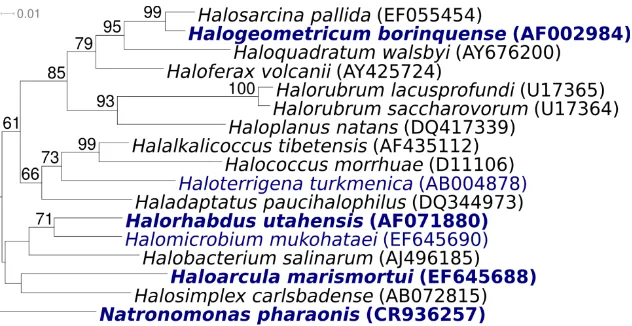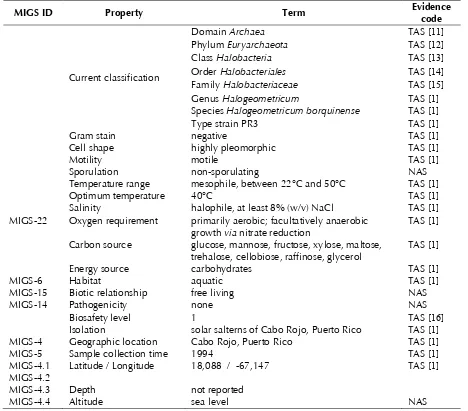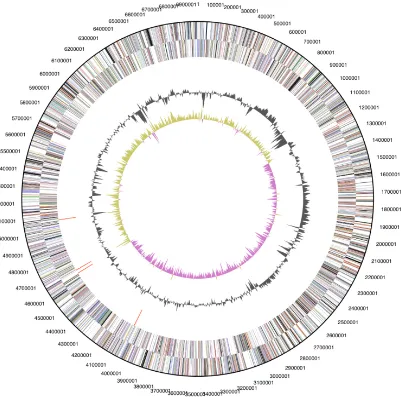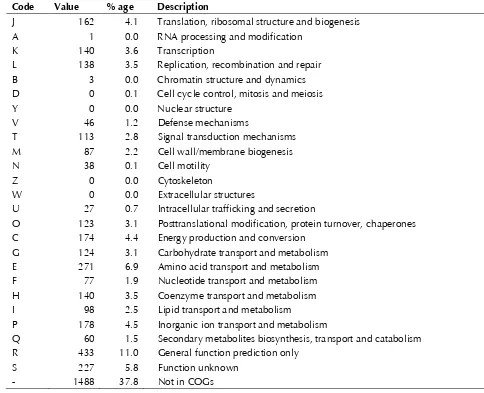Complete genome sequence of
Halogeometricum
borinquense
type strain (PR3
T)
Stephanie Malfatti1,2, Brian J. Tindall3, Susanne Schneider3, Regine Fähnrich3, Alla Lapidus1, Kurt LaButtii1, Alex Copeland1, Tijana Glavina Del Rio1, Matt Nolan1, Feng Chen1, Susan Lu-cas1, Hope Tice1, Jan-Fang Cheng1, David Bruce1,4, Lynne Goodwin1,4, Sam Pitluck1, Iain An-derson1, Amrita Pati1, Natalia Ivanova1, Konstantinos Mavromatis1, Amy Chen5, Krishna Pa-laniappan5, Patrik D’haeseleer1,2, Markus Göker3, Jim Bristow1, Jonathan A. Eisen1,6, Victor Markowitz5, Philip Hugenholtz1, Nikos C. Kyrpides1, Hans-Peter Klenk3, and Patrick Chain1,2*
1 DOE Joint Genome Institute, Walnut Creek, California, USA
2 Lawrence Livermore National Laboratory, Livermore, California, USA
3 DSMZ - German Collection of Microorganisms and Cell Cultures GmbH, Braunschweig, Germany
4 Los Alamos National Laboratory, Bioscience Division, Los Alamos, New Mexico, USA 5 Biological Data Management and Technology Center, Lawrence Berkeley National
Labora-tory, Berkeley, California, USA
6 University of California Davis Genome Center, Davis, California, USA
*Corresponding author: Patrick Chain
Keywords: halophile, free-living, non-pathogenic, aerobic, pleomorphic cells, euryarchaeon Halogeometricum borinquense Montalvo-Rodríguez et al. 1998 is the type species of the ge-nus, and is of phylogenetic interest because of its distinct location between the halobacterial genera Haloquadratum and Halosarcina. H. borinquense requires extremely high salt (NaCl) concentrations for growth. It can not only grow aerobically but also anaerobically using ni-trate as electron acceptor. The strain described in this report is a free-living, motile, pleomor-phic, euryarchaeon, which was originally isolated from the solar salterns of Cabo Rojo, Puer-to Rico. Here we describe the features of this organism, Puer-together with the complete genome sequence, and annotation. This is the first complete genome sequence of the halobacterial genus Halogeometricum, and this 3,944,467 bp long six replicon genome with its 3937 pro-tein-coding and 57 RNA genes is part of the Genomic Encyclopedia of Bacteria and Archaea project.
Introduction
Strain PR3
T(= DSM 11551 = ATCC 700274 = JCM
10706) is the type strain of
Halogeometricum
bo-rinquense
, representing the sole species of the
genus
Halogeometricum
[
1]. Strain PR3
Twas first
described by Montalvo-Rodríguez
et al
. in 1998 [
1]
as Gram-stain negative and motile. The organism
is of interest because of its position in the tree of
life, where it is located between members of the
Haloferax/Halorubrum
cluster within the large
euryarchaeal family
Halobacteraceae
(
Figure 1).
Here we present a summary classification and a
set of features for
H. geometricum
PR3
Ttogether
with the description of the complete genomic
se-quencing and annotation.
Classification and features
In addition to the solar salterns of Cabo Rojo,
Puerto Rico, where the type strain PR3
Tand two
H. geometricum
PR3
Tcells are highly pleomorphic
(short and long rods, squares, triangles and ovals)
and motile by peritrichous flagella (
Table 1and
Figure 2
). Cells lyse in distilled water. Gas vesicles
are present and are responsible for modifying the
color of colonies or cell suspensions from red to
pink.
H. geometricum
PR3
Tis aerobic, but also
ca-pable of anaerobic growth with nitrate. No
anae-robic growth on arginine (arginine dihydrolase is
not present). At least 8% NaCl (w/v) is required
for growth, reflecting the primary characteristic
requirement for high salt concentrations of the
Halobacteriaceae
[
18]. The optimal NaCl
concen-tration range is 20-25
%
NaCl (w/v) at 40°C
(op-timal growth temperature). Nitrate is reduced to
nitrite with the production of gas [
1]. Spores or
other resting stages have not been reported [
1].
H. geometricum
PR3
Tis capable of degrading
gela-tin, but starch is not hydrolysed. A number of
su-gars and polyols are used as carbon sources, and
acid is produced from some sugars [
1].
Figure 1
shows the phylogenetic neighborhood of
H.
borinquense
strain PR3
Tin a 16S rRNA based tree.
Analysis of the two 16S rRNA gene sequences in
the genome of strain PR3
Tindicated that the two
genes differ by five nucleotides (nts) from each
other, and by 3-5 nts from the previously
pub-lished 16S rRNA sequence generated from DSM
11551 (AF002984). The slight differences
be-tween the genome data and the reported 16S
rRNA gene sequence are most likely the result of
sequencing errors in the previously reported
se-quence data.
Chemotaxonomy
The quinone composition of
H. borinquense
strain
PR3
Thas not been recorded, but based on reports
from other members of the family
Halobacteria-ceae
menaquinones with eight isoprenoid units
are likely to be present. Typically both MK-8 and
MK-8 (VIII-H
2) are predicted. The lipids are based
on isoprenoid diether lipids, but the exact nature
of the isoprenoid side chains remains to be
inves-tigated. The major phospholipids are the diether,
isoprenoid analogs of phosphatidylglycerol and
methyl-phosphatidylglycerophosphate (typical of
all members of the family
Halobacteriaceae
), the
diether analog of phosphatidyl-glycerol sulfate is
absent [
1]. A single glycolipid has been reported
with an R
fvalue similar to that of the triglycosyl
diether from
Haloarcula marismortui
, but its
struc-ture has not been determined [
1]. The pigments
responsible for the red color of the cells have not
been determined, but it may be predicted that
they are carotenoids, probably bacterioruberins.
Outer cell layers are probably proteinaceous. The
presence of peptidoglycan has not been
investi-gated, but is generally absent from members of
this family
Halobacteriaceae.
Figure 1.
Phylogenetic tree of
H. borinquense
PR3
Twith a selection of type strains of the family
Ha-lobacteriaceae
, inferred from 1,433 aligned 16S rRNA characters [
2] under the maximum
Figure 2.
Scanning electron micrograph of
H. borinquense
PR3
T(Manfred
Rohde, Helmholtz Centre for Infection Research, Braunschweig)
Table 1. Classification and general features of H. borinquense PR3T according to the MIGS recommendations [10]
MIGS ID Property Term Evidence code
Current classification
Domain Archaea TAS [11]
Phylum Euryarchaeota TAS [12]
Class Halobacteria TAS [13]
Order Halobacteriales TAS [14]
Family Halobacteriaceae TAS [15]
Genus Halogeometricum TAS [1]
Species Halogeometricum borquinense TAS [1]
Type strain PR3 TAS [1]
Gram stain negative TAS [1]
Cell shape highly pleomorphic TAS [1]
Motility motile TAS [1]
Sporulation non-sporulating NAS
Temperature range mesophile, between 22°C and 50°C TAS [1]
Optimum temperature 40°C TAS [1]
Salinity halophile, at least 8% (w/v) NaCl TAS [1]
MIGS-22 Oxygen requirement primarily aerobic; facultatively anaerobic
growth via nitrate reduction TAS [1] Carbon source glucose, mannose, fructose, xylose, maltose,
trehalose, cellobiose, raffinose, glycerol TAS [1]
Energy source carbohydrates TAS [1]
MIGS-6 Habitat aquatic TAS [1]
MIGS-15 Biotic relationship free living NAS
MIGS-14 Pathogenicity none NAS
Biosafety level 1 TAS [16]
Isolation solar salterns of Cabo Rojo, Puerto Rico TAS [1]
MIGS-4 Geographic location Cabo Rojo, Puerto Rico TAS [1]
MIGS-5 Sample collection time 1994 TAS [1]
MIGS-4.1 MIGS-4.2
Latitude / Longitude 18,088 / -67,147 TAS [1]
MIGS-4.3 Depth not reported
MIGS-4.4 Altitude sea level NAS
Genome sequencing and annotation
Genome project history
This organism was selected for sequencing on the
basis of each phylogenetic position, and is part of
the
Genomic
Encyclopedia of
Bacteria and
Archaea
project. The genome project is deposited in the
Genome OnLine Database [
5]. The complete
ge-nome sequence has not yet been released from
GenBank. Sequencing, finishing and annotation
were performed by the DOE Joint Genome
Insti-tute (JGI). A summary of the project information is
shown in
Table 2.
Table 2. Genome sequencing project information
MIGS ID Property Term
MIGS-31 Finishing quality Finished
MIGS-28 Libraries used Two genomic libraries: 8kb pMCL200 and fosmid pcc1Fos Sanger libraries. One 454 pyrosequence standard library. MIGS-29 Sequencing platforms ABI3730, 454 GS FLX
MIGS-31.2 Sequencing coverage 9.7× Sanger; 21.8× pyrosequencing
MIGS-30 Assemblers Newbler, PGA
MIGS-32 Gene calling method GeneMark 4.6b, tRNAScan-SE-1.23, infer-nal 0.81 INSDC / Genbank ID CP001688
Genbank Date of Release September 10, 2009
GOLD ID Gc01108
NCBI project ID 20743
Database: IMG-GEBA 2501416934 MIGS-13 Source material identifier DSM 11551
Project relevance Tree of Life, GEBA
Growth conditions and DNA isolation
H. borinquense
PR3
T, DSM 11551, was grown in
DSMZ medium 372
35°C [
19]. DNA was isolated from 1-1.5 g of cell
paste using a Qiagen Genomic 500 DNA Kit
(Qia-gen, Hilden, Germany) with a modified protocol
for cell lysis, LALMP procedure according to Wu
et
al
. [
20]..
Genome sequencing and assembly
The genome was sequenced using a combination
of Sanger and 454 sequencing platforms. All
gen-eral aspects of library construction and
sequenc-ing performed at the JGI can be found at
reads were assembled using the Newbler
assemb-ler version v 2.0.0 (Roche). Large Newbassemb-ler contigs
were broken into 4,435 overlapping fragments of
1,000 bp and entered into assembly as
pseudo-reads. The sequences were assigned quality scores
based on Newbler consensus q-scores with
mod-ifications to account for overlap redundancy and
adjust inflated q-scores. A hybrid 454/Sanger
as-sembly was made using the PGA assembler.
Possi-ble mis-assemblies were corrected and gaps
be-tween contigs were closed by custom primer
walks from sub-clones or PCR products. A total of
2,826 Sanger finishing reads were produced. The
error rate of the completed genome sequence is
less than 1 in 100,000. Together all sequence
types provided 31.5× coverage of the genome.
Genome annotation
ge-nome for the Rfam profiles using INFERNAL
(v0.81) [
26]. Additional gene prediction analysis
and manual functional annotation was performed
within the Integrated Microbial Genomes (IMG)
platform [
27].
Metabolic network analysis
The metabolic Pathway/Genome Database (PGDB)
was computationally generated using Pathway
Tools software version 12.5 [
28] and MetaCyc
ver-sion 12.5 [
29], based on annotated EC numbers
and a customized enzyme name mapping file. It
has undergone no subsequent manual curation
and may contain errors, similar to a Tier 3 BioCyc
PGDB [
30].
Genome properties
The genome is 3,944,467 bp long and comprises
one main circular chromosome with a 60% GC
content and five plasmids. Of the 3,994 genes
pre-dicted, 3,937 were protein coding genes, and 57
RNAs. Thirty seven pseudogenes were also
identi-fied. A total of 62% of the genes were assigned a
putative function while the remaining ones are
annotated as hypothetical proteins. The properties
and the statistics of the genome are summarized
in
Table 3. The distribution of genes into COGs
functional categories is presented in
Figure 3and
Table 4
. A cellular overview diagram is presented
in
Figure 4, followed by a summary of metabolic
network statistics shown in
Table 5.
Table 3. Genome Statistics
Attribute Value % of Total
Genome size (bp) 3,944,467 100.00%
DNA Coding region (bp) 3,441,571 87.25%
DNA G+C content (bp) 2,364,339 59.94%
Number of replicons 1
Extrachromosomal elements 5
Total genes 3994 100.00%
RNA genes 57 1.90%
rRNA operons 2
Protein-coding genes 3937 98.57%
Pseudogenes 37 0.93%
Genes with function prediction 2486 62.24%
Genes in paralog clusters 741 18.55%
Genes assigned to COGs 2449 61.32%
Genes assigned Pfam domains 2385 59.71%
Genes with signal peptides 533 13.35%
Genes with transmembrane helices 971 24.31%
CRISPR repeats 1
Table 4. Number of genes associated with the general COG functional categories Code Value % age Description
J 162 4.1 Translation, ribosomal structure and biogenesis A 1 0.0 RNA processing and modification
K 140 3.6 Transcription
L 138 3.5 Replication, recombination and repair B 3 0.0 Chromatin structure and dynamics D 0 0.1 Cell cycle control, mitosis and meiosis
Y 0 0.0 Nuclear structure
V 46 1.2 Defense mechanisms
T 113 2.8 Signal transduction mechanisms M 87 2.2 Cell wall/membrane biogenesis
N 38 0.1 Cell motility
Z 0 0.0 Cytoskeleton
W 0 0.0 Extracellular structures
U 27 0.7 Intracellular trafficking and secretion
O 123 3.1 Posttranslational modification, protein turnover, chaperones C 174 4.4 Energy production and conversion
G 124 3.1 Carbohydrate transport and metabolism E 271 6.9 Amino acid transport and metabolism F 77 1.9 Nucleotide transport and metabolism H 140 3.5 Coenzyme transport and metabolism I 98 2.5 Lipid transport and metabolism
P 178 4.5 Inorganic ion transport and metabolism
Q 60 1.5 Secondary metabolites biosynthesis, transport and catabolism R 433 11.0 General function prediction only
S 227 5.8 Function unknown
Figure 4
. Schematic cellular overview diagram of all pathways of
H. borinquense
strain PR3
T.
Nodes represent metabolites, with shape indicating class of metabolite. Lines represent reactions.
Table 5. Metabolic Network Statistics
Attribute Value
Total genes 3801
Enzymes 578
Enzymatic reactions 687 Metabolic pathways 125
Metabolites 578
Acknowledgements
This work was performed under the auspices of the US Department of Energy Office of Science, Biological and Environmental Research Program, and by the Universi-ty of California, Lawrence Berkeley National Laboratory under contract No. DE-AC02-05CH11231, Lawrence
Livermore National Laboratory under Contract No. DE-AC52-07NA27344, and Los Alamos National Laborato-ry under contract No. DE-AC02-06NA25396, as well as German Research Foundation (DFG) INST 599/1-1.
References
1. Montalvo-Rodríguez R, Vreeland RH, Oren A, Kessel M, Betancourt C, López-Garriga J. Halo-geometricum borinquense gen. nov., sp. nov., a novel halophilic archaeon from Puerto Rico. Int J Syst Bacteriol 1998; 48:1305-1312 2. Lee C, Grasso C, Sharlow MF. Multiple sequence
alignment using partial order graphs. Bioinformat-ics 2002; 18:452-464
3. Felsenstein J. Evolutionary trees from DNA se-quences: a maximum likelihood approach. J Mol Evol 1981; 17:368-376
4. Stamatakis A, Hoover P, Rougemont J. A rapid bootstrap algorithm for the RAxML web-servers. Syst Biol 2008; 57:758-771
5. Liolios K, Mavromatis K, Tavernarakis N, Kyrpides NC. The Genomes OnLine Database (GOLD) in 2007: status of genomic and metagenomic projects
2008; 36:D475-D479
6. Burns DG, Camakaris HM, Janssen PH, Dyall-Smith ML. Combined use of cultivation-dependent and cultivation-independent methods indicates that members of most haloarchaeal groups in an Australian crystallizer pond are cultivable. Appl Environ Microbiol 2004; 70:5258-5265
7. Maturrano L, Santos F, Rosselló-Mora R, Antón J. Microbial diversity in Maras Salterns, a hypersaline environment in the Preuvian Andes. Appl Environ Microbiol 2006; 72:3887-3895
8. Fukushima T, Usami R, Kamekura M. A traditional Japanese-style salt field is a nich for haloarchaeal strains that can survive in 0.5% salt solution. Saline Systems 2007; 72:3887-3895.
re-low-salt, sulphide- and sulphur-rich spring. Appl Environ Microbiol 2004; 70:2230-2239
10. Field D, Garrity G, Gray T, Morrison N, Selengut J, Sterk P, Tatusova T, Thomson N, Allen MJ, Angi-uoli SV et al. Towards a richer description of our complete collection of genomes and metagenomes: the “Minimum Information about a Genome Se-quence” (MIGS) specification. Nat Biotechnol
2008; 26:541-547
11. Woese CR, Kandler O, Wheelis ML. Towards a natural system of organisms: proposal for the do-mains Archaea, Bacteria, and Eucarya. Proc Natl Acad Sci USA 1990; 87: 4576-4579
12. Garrity GM, Lilburn TG, Cole JR, Harrison SH, Euzéby J, Tindall BJ. Taxonomic Outline of the Bacteria and Archaea. Release 7.7 March 6, 2007. Michigan State University Board of Trustees. DOI: 10.1601/TOBA7.7.
http://www.taxonomicoutline.org/index.php/toba 13. Grant WD, Kamekura M, McGenity TJ, Ventosa A.
Class III. Halobacteria class. nov. In: DR Boone, RW Castenholz, GM Garrity (eds): Bergey's Ma-nual of Systematic Bacteriology, 2nd edition, Vol. 1, The Archaea and the deeply branching and pho-totrophic Bacteria, Springer-Verlag, New York, 2001.p 294.
14. Grant WD, Larsen H. Group III. Extremely halo-philic archaeobacteria. Order Halobacteriales ord. nov. In: JT Staley, MP Bryant, N. Pfennig, JG Holt (eds), Bergey's Manual of Systematic Bacteriology, 1st edition, Vol. 3, The Williams & Wilkins Co., Baltimore, 1989, pp. 2216-2218.
15. Gibbons NE. Family V. Halobacteriaceae fam. nov. In: RE Buchanan, NE Gibbons (eds): Bergey's Ma-nual of Determinative Bacteriology, 8th edition, The Williams & Wilkins Co, Baltimore, 1974, p. 269.
16. Anonymous. Biological Agents: Technical rules for biological agents www.baua.de TRBA 466. 17. Ashburner M, Ball CA, Blake JA, Botstein D, Butler
H, Cherry JM, Davis AP, Dolinski K, Dwight SS, Eppig JT, et al. The Gene Ontology Consortium. Gene ontology: tool for the unification of biology. Nat Genet 2000; 25:25-29
18. Norton C. Rediscovering the ecology of halobacte-ria. ASM News 1992; 58:363-367.
19. List of media used at DSMZ for cell growth: http://www.dsmz.de/microorganisms/media_list.ph p
20. Wu M, Hugenholtz P, Mavromatis K, Pukall R, Dalin E, Ivanova N, Kunin V, Goodwin L, Wu M, Tindall BJ, et al.. A phylogeny-driven genomic en-cyclopedia of Bacteria and Archaea. Nature 2009 (In press)
21. Besemer J, Lomsadze A, Borodovsky M. Gene-MarkS: a self-training method for prediction of gene starts in microbial genomes. Implications for finding sequence motifs in regulatory regions. Nucleic Acids Res 2001; 29:2607-2618
22. Markowitz VM, Mavromatis K, Ivanova NN, Chen IMA, Chu K, Kyrpides NC. Expert Review of Func-tional Annotations for Microbial Genomes. Bioin-formatics 2009 25:2271-2278.
23 Pati A, Ivanova N, Mikhailova, N, Ovchinikova G, Hooper SD, Lykidis A, Kyrpides NC. GenePRIMP: A Gene Prediction Improvement Pipeline for mi-crobial genomes. (Submitted) 2009.
24. Lowe TM, Eddy SR. tRNAscan-SE: a program for improved detection of transfer RNA genes in ge-nomic sequence. Nucleic Acids Res 1997; 25
:955-964
25. Lagesen K, Hallin P, Rødland EA, Staerfeldt HH, Rognes T, Ussery DW. RNAmmer: consistent and rapid annotation of ribosomal RNA genes. Nucleic Acids Res 2007; 35:3100-3108
26. Griffiths-Jones S, Moxon S, Marshall M, Khanna A, Eddy SR, Bateman A. Rfam: annotating non-coding RNAs in complete genomes. Nucleic Acids Res 2005; 33:D121-D124
27. Markowitz VM, Szeto E, Palaniappan K, Grechkin Y, Chu K, Chen IMA, Dubchak I, Anderson I, Lyki-dis A, Mavromatis K, et al. The Integrated Microbi-al Genomes (IMG) system in 2007: data content and analysis tool extensions. Nucleic Acids Res 2008; 36:D528-D533
28. Karp PD, Paley SM, Romero P. The Pathway Tools Software. Bioinformatics 2002; 18:S225-S232
Acids Res 2008; 36:D623-D631
30. Karp PD, Ouzounis CA, Moore-Kochlacs C, Gol-dovsky L, Kaipa P, Ahren D, Tsoka S, Darzentas N,
Kunin V, Lopez-Bigas N. Expansion of the BioCyc collection of pathway/genome databases to 160 genomes. Nucleic Acids Res 2005; 33:6083-6089.





